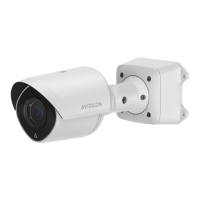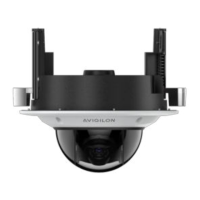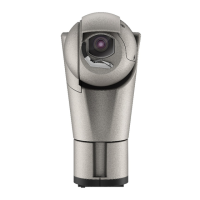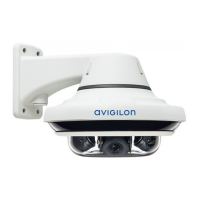Note: This option is disabled by default. It is recommended that you do NOT enable
this option on cameras that are installed in locations where additional light sources
(such as headlights, floodlights, and streetlights) may cause the camera to frequently
switch between day and night modes.
6. To adjust the exposure of the image, adjust the Exposure Settings:
l
Flicker Control: If your video image flickers because of fluorescent lights around the camera,
you can reduce the effects of the light by setting the Flicker Control to the same frequency as
your lights. Generally, Europe is 50Hz and North America is 60Hz.
Note: Resetting this control will stop the video stream for a few seconds.
l
Enable Wide Dynamic Range: You can enable automatic color adjustments through Wide
Dynamic Range (WDR). This allows the camera to adjust the video image to accommodate
scenes where bright light and dark shadow are clearly visible.
l
Exposure: You can allow the camera to control the exposure by selecting Automatic, or you
can set a specific exposure rate.
Note: Increasing the manual exposure time may affect the image rate.
l
Exposure Offset: This is an advanced setting that allows you to compensate for unusual
lighting conditions by setting an exposure offset value. Negative values result in a persistently
darker image, and positive values result in a persistently brighter image.
l
Maximum Exposure: You can limit the automatic exposure setting by selecting a maximum
exposure level. The Maximum Exposure drop-down list is only available when the Exposure
setting is set to Automatic.
By setting a maximum exposure level for low-light situations, you can control the camera's
exposure time to let in the maximum amount of light without creating blurry images.
l
Priority: You can set Max Image Rate or Exposure as the priority.
o
When set to Max Image Rate, the camera will maintain the set image rate as the priority
and will not adjust the exposure beyond what can be recorded for the set image rate.
o
When set to Exposure the camera will maintain the exposure setting as the priority, and
will override the set image rate to achieve the best image possible.
l
Maximum Iris: You can limit the largest iris opening the lens will use by setting a maximum iris
opening. This value is an f-number. It is also given in EV relative to the widest possible opening
of the lens. This setting is only available when the Iris setting is set to Automatic.
The iris opening also affects how much of the scene is in focus. The smallest f-number (0 EV)
sets the iris to the widest possible opening. This allows the most light into the camera, but
places less of the scene in focus. Larger f-numbers (negative EV) result in a smaller maximum
Image and Display 17

